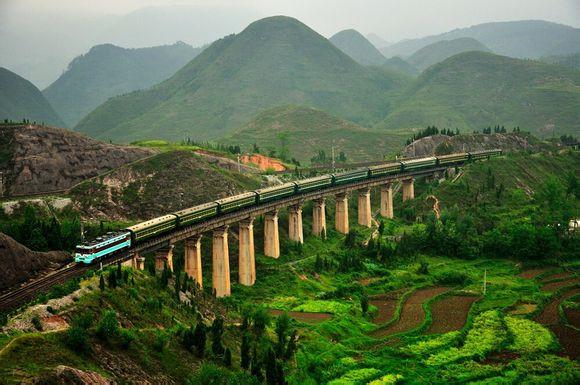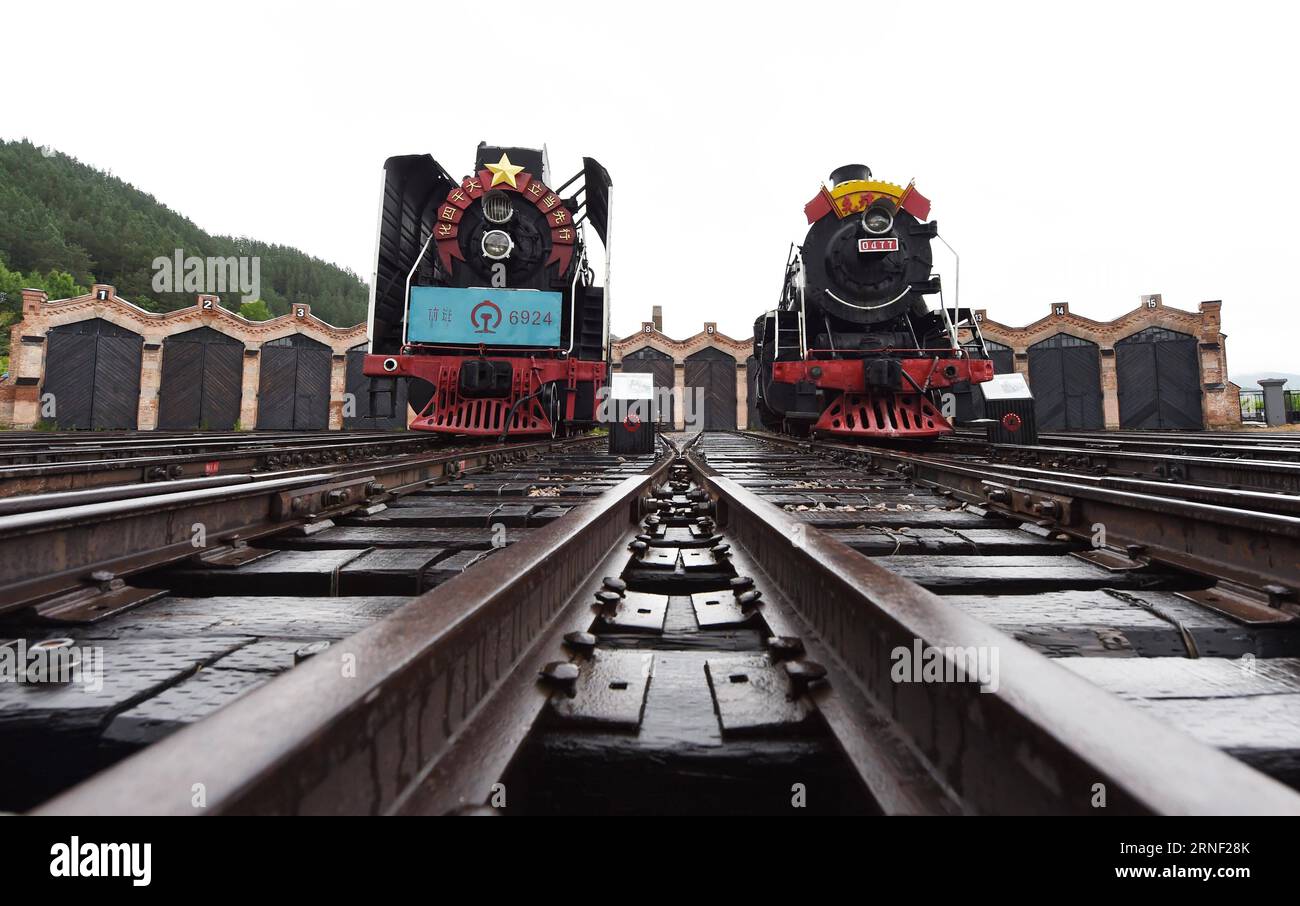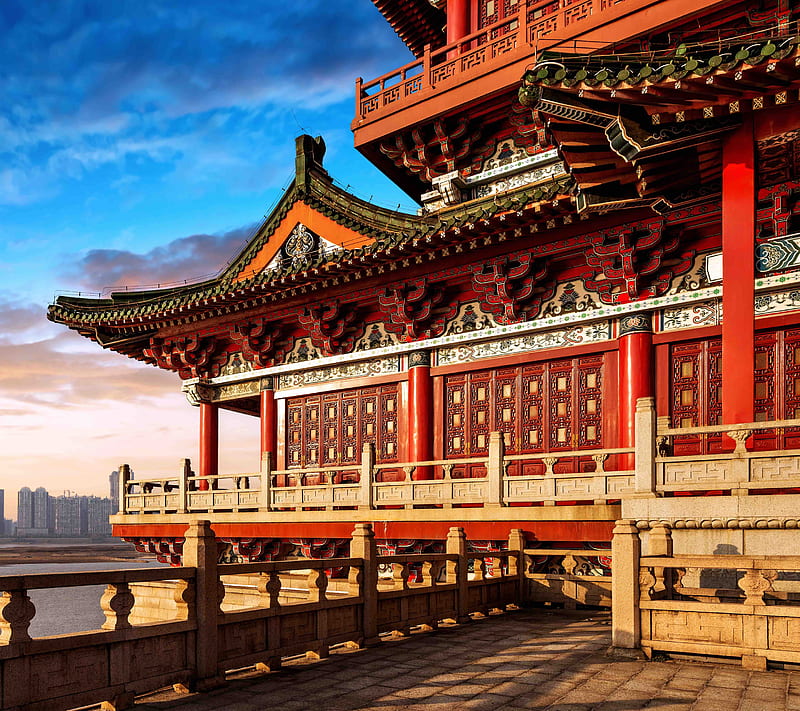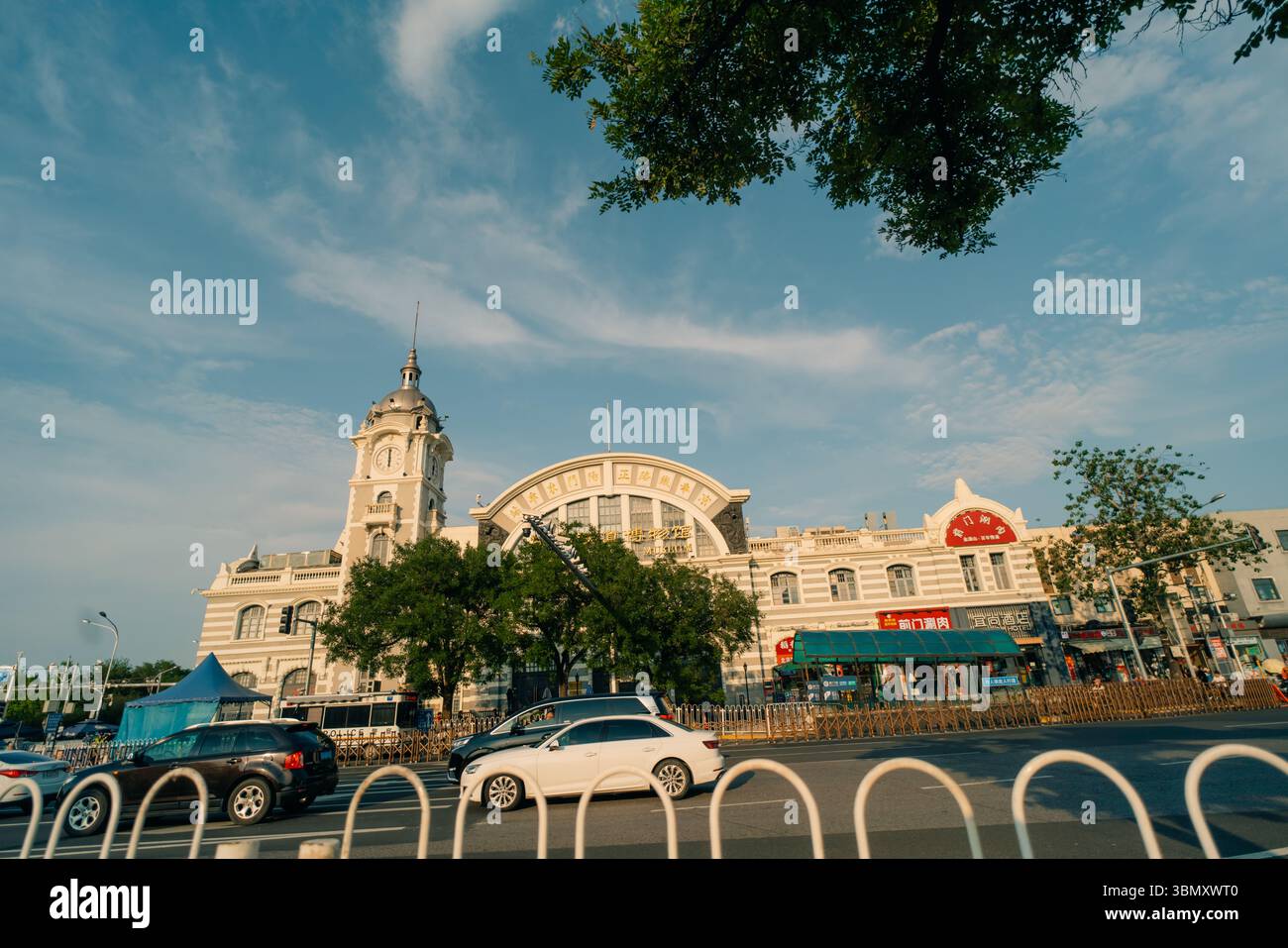A Photographer’s Paradise: Capturing the Beauty of the Chinese Eastern Railway Buildings

An Essential Guide to Visiting Chinese_Eastern_Railway_Buildings
As you embark on a journey through Northeast China, prepare to step back in time and explore the remarkable legacy of the Chinese Eastern Railway (CER). This vast infrastructure network, stretching over 2,489 kilometers, was constructed at the turn of the twentieth century under Russian imperial influence. Today, the remnants of this engineering marvel stand as a testament to cultural exchange, historical significance, and architectural innovation.
The buildings and structures associated with the CER are not merely relics of the past; they are vibrant pieces of living heritage that continue to shape the local landscape and culture. With nearly 2,000 surviving facilities—from grand railway stations to humble bridges—each site offers a unique glimpse into the transformative impact the railway had on the region. As you wander through these historic buildings, you’ll discover the stories of the people who built and used them, the geopolitical forces that shaped their construction, and the ongoing journey of preserving this invaluable heritage.
While many of these sites have fallen into disrepair, there is a growing recognition of their significance, and efforts are underway to restore and protect them. Whether you’re an architecture enthusiast, a history buff, or simply a curious traveler, the Chinese Eastern Railway buildings promise an enriching experience. Join us as we delve into the fascinating world of CER, where each stop along the route reveals layers of history, culture, and the enduring spirit of a region in transformation.
In This Guide
- An Essential Guide to Visiting Chinese_Eastern_Railway_Buildings
- The Rich History and Legends of Chinese_Eastern_Railway_Buildings
- Main Highlights: What You Absolutely Can’t Miss
- Planning Your Visit: A Practical Guide
- Tickets: Prices, Booking, and Tips
- How to Get There: A Complete Transportation Guide
- Local Cuisine and Accommodation Nearby
- Frequently Asked Questions
- Final Thoughts on Your Trip
The Rich History and Legends of Chinese_Eastern_Railway_Buildings
The story of the Chinese Eastern Railway (CER) is one steeped in history, intertwined with the fabric of Northeast China’s development and modernization at the turn of the twentieth century. Originally constructed by Russian engineers and laborers, this monumental railway stretches approximately 2,489 kilometers, linking the transcontinental routes and serving as a vital artery for commerce and communication.
The CER was more than just a railway; it symbolized a significant cultural transfer, bringing new technologies and ideas to a region that had been relatively undeveloped. The railway’s construction was a monumental feat of engineering, requiring the establishment of numerous buildings and facilities, many of which still stand today. Among these structures are stations, bridges, and residential quarters, each carrying its own stories and historical significance.
One of the most notable aspects of the CER is the architectural diversity reflected in its buildings. Influenced by various styles, including Russian and local Chinese elements, these structures are not just functional; they embody a rich cultural narrative. The blending of architectural influences illustrates the interactions between different cultures and the complexities of colonial legacies in the region.
As the railway facilitated the movement of people and goods, it also played a crucial role in shaping the urban landscapes of cities along its route. Cities such as Harbin, once a humble settlement, transformed into vibrant urban centers, showcasing a unique architectural heritage that continues to attract international attention. The railway’s influence extended beyond transportation; it fostered economic growth, educational advancements, and cultural exchanges, making it a pivotal factor in Northeast China’s modernization.
However, the rich history of the CER and its buildings has often been overshadowed by the more prominent narratives of ancient Chinese heritage. For many years, the tangible cultural assets associated with the CER fell into neglect, viewed as relics of a colonial past rather than as integral elements of cultural heritage. This oversight has led to significant challenges in preserving these structures, as urbanization and modernization pressures threaten their existence.
In recent years, there has been a growing recognition of the importance of these buildings as cultural heritage. Scholars and heritage advocates are increasingly emphasizing the need for conservation and appreciation of the CER’s architectural legacy. This evolving understanding is part of a broader movement in China to redefine cultural heritage to include modern constructions, allowing for a more comprehensive approach to heritage conservation.
Legends and anecdotes surrounding the CER further enrich its historical narrative. Tales of the railway workers, their struggles, and triumphs, as well as stories of travelers who traversed its length, add a human dimension to the cold steel of the tracks. These narratives are crucial for understanding the significance of the railway in the lives of those who lived in its shadow, fostering a sense of identity and community that persists to this day.
As international travelers explore the remnants of the Chinese Eastern Railway, they not only witness the physical structures left behind but also engage with the layered histories and legends that give these buildings their unique character. The CER stands as a testament to a transformative era in Chinese history, and its buildings invite visitors to delve into a narrative that is as complex as it is captivating, reflecting the dynamic interplay of cultures, economies, and histories that have shaped Northeast China.

Chinese_Eastern_Railway_Buildings.
Main Highlights: What You Absolutely Can’t Miss
When exploring the historical and architectural wonders of the Chinese Eastern Railway (CER), several key highlights stand out, each offering a glimpse into the rich tapestry of culture, history, and engineering that shaped Northeast China. Here’s what you absolutely can’t miss:
1. Harbin Railway Station
This grand station is a testament to the architectural splendor of the early 20th century. Built in the Russian architectural style, the station features intricate detailing and a majestic clock tower. As one of the most important railway hubs along the CER, it serves as a vibrant crossroads for travelers and offers a glimpse into the region’s historical significance.
2. The Old Harbin Customs House
Situated near the banks of the Songhua River, this building represents the economic pulse of the region during the railway’s peak operational years. Its neoclassical design reflects a blend of Eastern and Western architectural influences, symbolizing the cultural exchange that the CER facilitated.
3. The Russian Orthodox Church of St. Sophia
While not a railway building per se, this iconic church stands as a historical landmark deeply intertwined with the railway’s legacy. With its stunning onion domes and ornate frescoes, it serves as a reminder of the Russian influence in Harbin and the cultural intermingling that occurred due to the railway’s construction.
4. The Harbin Railway Bureau Building
An impressive example of early 20th-century architecture, this building served as the administrative center for the railway operations. Its stately facade and historical significance make it a must-visit for those interested in the operational history and impact of the CER.
5. Siping Railway Station
Located further along the railway, this station showcases the evolution of railway architecture in China. The station combines functionality with aesthetic appeal and stands as a regional hub where travelers can experience the local culture and culinary delights.
6. The Mudanjiang Railway Station
Renowned for its unique design blending traditional Chinese architectural elements with Russian influences, Mudanjiang Station is a charming stop along the CER. The station’s picturesque setting and historical context provide travelers with an authentic glimpse of life along the railway.
7. The Old Railway Bridge over the Songhua River
This engineering marvel is not only a vital transportation link but also an iconic landmark. The bridge’s robust design and striking views of the river make it a perfect spot for photography enthusiasts and those interested in the railway’s engineering achievements.
8. Cultural Exhibits at the CER Museum
Visit the museum dedicated to the Chinese Eastern Railway, where you can explore exhibits that detail the construction, cultural significance, and impact of the railway on Northeast China. Artifacts, photographs, and models provide a comprehensive understanding of the railway’s legacy.
9. Stroll Along the Old Railway Tracks
For a unique experience, take a walk along the remnants of the old railway tracks. The path offers picturesque views of the surrounding landscapes and a tangible connection to the history of the railway. This leisurely stroll allows you to reflect on the profound transformations that the CER brought to the region.
10. Local Cuisine and Markets
No visit to the CER sites is complete without indulging in the local cuisine. Explore the vibrant markets and enjoy traditional dishes influenced by the diverse cultures that the railway connected. Sampling local delicacies is a delightful way to experience the region’s rich heritage.
Each of these highlights not only showcases the architectural beauty and historical significance of the Chinese Eastern Railway but also invites travelers to engage with the stories and cultures that shaped this remarkable region. Make sure to set aside ample time to fully immerse yourself in the legacy of the CER!

Chinese_Eastern_Railway_Buildings.
Planning Your Visit: A Practical Guide
Your Essential Guide to Visiting the Chinese Eastern Railway Buildings
Exploring the Chinese Eastern Railway (CER) buildings is like stepping into a living museum that captures the essence of Northeast China’s rich historical tapestry. Constructed during a pivotal era in the late 19th and early 20th centuries, these architectural marvels offer a unique glimpse into the region’s past. Whether you’re an architecture enthusiast, a history buff, or simply a curious traveler, this guide will help you navigate your visit effectively.
Getting There
Location: The CER stretches across a vast network of over 2,489 kilometers, primarily in Northeast China, with significant buildings located in cities such as Harbin, Changchun, and Shenyang.
Transportation:
– By Train: The railway itself is still operational, making it a fascinating choice for travel. Regular services connect major cities along the route, allowing you to experience the railway as it was intended.
– By Plane: Major cities are serviced by airports with connections to international and domestic flights. From there, local trains, buses, or taxis can take you to the designated sites.
– By Car: Renting a car can provide flexibility, especially if you wish to explore smaller towns and lesser-known railway buildings.
Key Sites to Visit
-
Harbin Railway Station: An iconic example of Russian architectural influence, this station is one of the largest in Asia and serves as a hub for travelers. Don’t miss its stunning facade and intricate interior designs.
-
The Old Harbin Customs House: A beautiful blend of neoclassical and Russian architectural styles, this structure offers a glimpse into the economic history of the region.
-
Shenyang Railway Station: Known for its unique architectural style and historical significance, this station showcases the blend of Eastern and Western influences in its design.
-
The Former Railway Bureau in Changchun: This building stands as a testament to the administrative history of the railway and features exhibitions related to its heritage.
-
Various Bridge Structures: Along the route, you’ll find numerous bridges that were pivotal during the railway’s construction. Some are still in use today, providing a stunning backdrop for photographs.
Best Time to Visit
The ideal time to visit the CER buildings is during spring (April to June) and autumn (September to November) when the weather is mild and conducive for exploration. Summer can be hot, while winter temperatures can drop significantly, affecting travel plans.
Tips for a Smooth Visit
-
Plan Your Route: Given the extensive network of buildings, it’s wise to plan your itinerary in advance. Focus on key cities and prioritize the sites that interest you most.
-
Local Guides: Consider hiring a local guide who can provide in-depth knowledge about the history and architecture of the buildings, enriching your experience.
-
Language: While major cities may have English-speaking staff, it’s beneficial to learn a few basic Mandarin phrases or use translation apps to ease communication.
-
Cultural Etiquette: Respect local customs and traditions. When visiting historical sites, observe guidelines regarding photography and entry restrictions.
-
Stay Hydrated and Snack Ready: Bring water and snacks, especially if you plan to explore rural areas where amenities may be limited.
Preservation and Heritage
As you explore the CER buildings, take a moment to appreciate their significance as cultural heritage. Many of these structures are undergoing efforts for restoration and preservation, aiming to highlight their historical value while benefiting local communities. Engaging with these sites responsibly supports ongoing conservation efforts.
Conclusion
Visiting the Chinese Eastern Railway buildings offers a fascinating journey through time, marked by the stories of innovation, culture, and history that define Northeast China. With careful planning and an open mind, you’ll not only witness architectural beauty but also gain a deeper understanding of the region’s past. Whether you’re traveling solo or with companions, the legacy of the CER promises an unforgettable adventure.

Chinese_Eastern_Railway_Buildings.
Tickets: Prices, Booking, and Tips
When exploring the fascinating Chinese Eastern Railway Buildings, it’s essential to plan your visit carefully, especially regarding ticket prices, booking options, and helpful tips to ensure a smooth experience.
Ticket Prices
The entry fees for the various sites along the Chinese Eastern Railway can vary based on the specific building or facility you wish to visit. Typically, you can expect prices to range from ¥20 to ¥100 (approximately $3 to $15 USD) per person. Some historical buildings might offer free entry on certain national holidays or during special events, so it’s worth checking in advance.
Booking Options
Most of the sites along the Chinese Eastern Railway do not require advance booking, allowing for spontaneous visits. However, for larger groups or special tours, it’s advisable to book tickets in advance. You can often reserve tickets through the official websites of the heritage sites or local tourism offices. Popular sites may also have ticketing services available on platforms like WeChat or Alipay, which are widely used in China.
Tips for Your Visit
-
Timing Your Visit: Try to visit during weekdays to avoid crowds, especially during peak tourist seasons (June to August). Early mornings or late afternoons are also great times to enjoy a quieter experience.
-
Guided Tours: Consider joining a guided tour to gain deeper insight into the historical significance and architectural features of the buildings. Many local guides are knowledgeable and can share fascinating stories about the railway’s history.
-
Language Considerations: While major tourist sites may have English signage, not all guides are fluent in English. If you’re not comfortable with Mandarin, you might want to download translation apps or consider hiring a bilingual guide.
-
Photography: The architecture along the railway is stunning, so be sure to bring your camera! Just keep in mind that some locations may have restrictions on photography, especially inside certain buildings.
-
Transportation: The sites are often spread out along the railway, so plan your transportation accordingly. Public buses and taxis are readily available, but renting a bicycle or using ride-sharing apps can also be a fun way to explore.
-
Stay Hydrated and Snack Smart: Bring water and snacks, particularly if you plan to spend a day visiting multiple sites. Many of the areas may not have convenient food options nearby.
By keeping these details in mind, you can fully immerse yourself in the rich heritage of the Chinese Eastern Railway Buildings while enjoying your travels through this historically significant region. Safe travels!
How to Get There: A Complete Transportation Guide
To embark on an adventure to the Chinese Eastern Railway Buildings, a remarkable testament to early 20th-century architecture and geopolitics, you’ll find that reaching this unique destination is both straightforward and enriching. Here’s your comprehensive transportation guide to ensure your journey is seamless and enjoyable.
Arriving in Northeast China
By Air
The closest major airports to the Chinese Eastern Railway Buildings are:
- Harbin Taiping International Airport (HRB): Located approximately 35 kilometers from Harbin city center, this airport serves several international and domestic flights. From here, you can rent a car, take a taxi, or use ride-sharing apps to reach your destination.
- Shenyang Taoxian International Airport (SHE): About 80 kilometers from the railway buildings, this airport offers flights from major cities in China and some international locations. Similar to Harbin, you can access taxis or rental cars for the journey onward.
By Train
The railway network in China is extensive and well-connected. Consider taking a high-speed train to Harbin or Shenyang:
- From Beijing to Harbin: High-speed trains run frequently and take around 4-5 hours. Trains depart from Beijing West Railway Station and arrive at Harbin West Railway Station.
- From Shanghai to Harbin: The journey takes approximately 12-15 hours, with a few high-speed options available.
Once in Harbin, you can access local public transport or taxis to reach the nearby railway buildings.
Local Transportation Options
Buses and Public Transit
Once you arrive in Harbin or the surrounding areas, local buses can be a budget-friendly way to navigate:
- Harbin Public Buses: Use the city’s bus network to get close to the buildings. Routes may vary, so it’s advisable to check local transit maps or ask locals for the best route.
- Subway: Harbin has a developing subway system that can help you reach central locations. Check the latest routes for any connections to your destination.
Taxis and Ride-Sharing
Taxis are readily available in Harbin and other cities in Northeast China. Look for the designated taxi stands or use ride-sharing apps like Didi Chuxing for convenience. This might be the fastest way to get directly to the buildings, especially if you’re traveling with luggage or in a group.
Exploring the Buildings
Once you arrive at the Chinese Eastern Railway Buildings, you’ll find a rich tapestry of historical architecture awaiting your exploration. Be sure to wear comfortable shoes, as you may want to walk around to fully appreciate the various structures—many of which are remnants of a significant cultural heritage shaped by the railway’s history.
Additional Tips
- Language: While major cities like Harbin may have signs in English, it’s helpful to download translation apps or have a phrasebook handy for communication.
- Local Cuisine: Take advantage of your travel by sampling local dishes in nearby restaurants or street markets; Northeast China is known for its hearty fare.
- Seasonal Considerations: The best times to visit are spring (April to June) and autumn (September to October) when the weather is mild. Winters can be quite cold, so be prepared with appropriate attire if you choose to visit during that season.
With this guide, you’re well-equipped to navigate your way to the Chinese Eastern Railway Buildings, where history and culture intertwine in a captivating journey through time. Safe travels!

Chinese_Eastern_Railway_Buildings.
Local Cuisine and Accommodation Nearby
Exploring the area around the Chinese Eastern Railway Buildings offers a delightful opportunity to sample local cuisine and find comfortable accommodations that reflect the rich heritage of Northeast China. Here are some recommendations for food and lodging that will enhance your travel experience.
Local Cuisine
-
Northeast Chinese Dumplings (Jiaozi)
A staple of the region, these dumplings are often filled with minced meat and vegetables, then boiled or pan-fried to perfection. For an authentic taste, visit Dumpling House in Harbin, where you can watch the chefs prepare your meal right before your eyes. Pair your dumplings with a dipping sauce made from soy sauce, vinegar, and chili oil for an extra kick. -
Siberian-Style BBQ
Embrace the region’s unique culinary influence with a visit to Siberian BBQ Corner. Here, you’ll find skewers of marinated meats grilled over an open flame, served with fresh vegetables and traditional sauces. This casual dining experience is perfect for enjoying a hearty meal after a day of exploration. -
Hot Pot
Experience the communal dining culture of hot pot at Spicy Pot Restaurant. Choose from an array of fresh ingredients, including thinly sliced meats, seafood, and seasonal vegetables, and cook them in bubbling spicy broth at your table. It’s a fun way to interact with fellow diners and savor the bold flavors of Northeast China. -
Manchu-Han Imperial Feast
For a taste of history, indulge in a Manchu-Han banquet at Imperial Feast Restaurant. This dining experience showcases traditional dishes that were once enjoyed by Chinese emperors, featuring a variety of delicacies from both Manchu and Han cultures. Reservations are recommended for this lavish meal.
Accommodation
-
Harbin Shangri-La Hotel
A luxurious option located near the railway buildings, this hotel offers stunning views of the Songhua River and exquisite amenities. With spacious rooms, a spa, and multiple dining options, it’s perfect for travelers seeking comfort and elegance after a day of sightseeing. -
GreenTree Inn Harbin Central Avenue
For budget-conscious travelers, this hotel provides a cozy and convenient stay with modern facilities. Located close to the historic Central Avenue, it’s an ideal base for exploring local shops and dining options while being just a short distance from the Chinese Eastern Railway Buildings. -
Sofitel Harbin
Blending French elegance with local charm, the Sofitel offers stylish rooms and a renowned restaurant. Enjoy a buffet breakfast featuring both international and local dishes to fuel your adventures. The hotel’s central location makes it easy to visit key attractions, including the railway buildings. -
Zhongyang Street Youth Hostel
Perfect for backpackers and young travelers, this hostel offers a social atmosphere and affordable dormitory-style accommodations. Located near Harbin’s famous Zhongyang Street, you’ll have easy access to vibrant nightlife and local eateries, making it an excellent choice for budget travelers looking to connect with fellow explorers.
Whether you are indulging in delicious regional dishes or resting in a cozy abode, the area surrounding the Chinese Eastern Railway Buildings is sure to provide a memorable culinary and accommodation experience that complements the rich history of this unique heritage site.

Chinese_Eastern_Railway_Buildings.
Frequently Asked Questions
Frequently Asked Questions about the Chinese Eastern Railway Buildings
-
What are the Chinese Eastern Railway Buildings?
The Chinese Eastern Railway Buildings comprise a collection of architectonic structures built along the railway line constructed by Russia in Northeast China during the late 19th and early 20th centuries. These buildings reflect the region’s historical significance and architectural diversity and are considered important cultural heritage sites. -
How can I visit the Chinese Eastern Railway Buildings?
The buildings are primarily located in cities along the railway route, such as Harbin and Changchun. Public transportation options like trains, buses, and taxis are available for easy access. Many of the sites are open to the public, but it’s advisable to check for specific visiting hours or guided tours in advance. -
What is the significance of the Chinese Eastern Railway?
The railway was a crucial infrastructure project that transformed Northeast China, facilitating modernization and cultural exchange in the region. It played a vital role in the geopolitical dynamics of the early 20th century and laid the groundwork for urban development in cities along its path. -
Are there guided tours available for the railway buildings?
Yes, many local tour companies offer guided tours that provide in-depth knowledge about the history and architecture of the Chinese Eastern Railway Buildings. These tours often include visits to key sites and can enhance your understanding of the cultural heritage associated with the railway. -
What types of buildings can I expect to see?
Travelers will encounter a variety of structures, including historical stations, administrative buildings, and residential quarters, each showcasing different architectural styles influenced by Russian, Chinese, and local designs. Some notable examples include the Harbin Railway Station and the Old Railway Station in Changchun. -
Is there an entrance fee to visit these buildings?
Many of the buildings are free to visit, especially those that are part of public spaces or parks. However, some specific sites, particularly museums or restored historical buildings, may charge an entrance fee. It’s best to check the particular site you plan to visit. -
What should I know about the preservation of these buildings?
Although many buildings are recognized for their cultural heritage value, some have faced neglect and disrepair over the years. Local initiatives are underway to promote the conservation of these sites, but travelers should remain mindful of their historical context and support preservation efforts. -
Are there any local customs or etiquette tips for visiting?
When visiting historical sites, it’s respectful to maintain a quiet demeanor and avoid touching or climbing on the buildings. Photography is generally allowed, but be aware of any restrictions. Engaging with local guides can also enrich your experience and help you understand the cultural nuances of the area.
Final Thoughts on Your Trip
As your journey through the remarkable Chinese Eastern Railway Buildings comes to a close, it’s essential to reflect on the rich tapestry of history, culture, and resilience that these structures embody. Spanning over a century, the railway stands not only as a testament to engineering prowess but also as a bridge connecting diverse cultures and stories.
Each building along the route tells a tale of its time, showcasing the evolution of Northeast China from a frontier region to a vibrant part of the modern world. By exploring these historical sites, you are not just witnessing architectural beauty; you are participating in the ongoing narrative of heritage preservation and cultural appreciation.
As international travelers, your engagement with the Chinese Eastern Railway’s legacy can inspire a deeper understanding of the complex interplay between history and modernity. The stories etched into these walls invite you to pause, reflect, and appreciate the journey that has shaped the present.
Carry these experiences with you, share them with others, and contribute to the collective memory of this extraordinary part of the world. Your visit may be just a chapter in the story of the CER, but it is a vital one—helping to shine a light on the importance of preserving our shared heritage for generations to come. Thank you for embarking on this journey, and may the echoes of the past continue to resonate in your travels ahead.